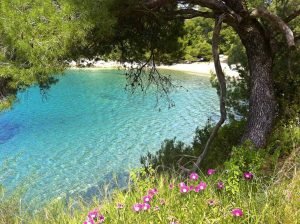Would you like to witness the beauty of untouched nature? That is what you will experience when you visit Mljet National Park.
It is one of the 8 major national parks in Croatia and one that offers quite a unique attraction.
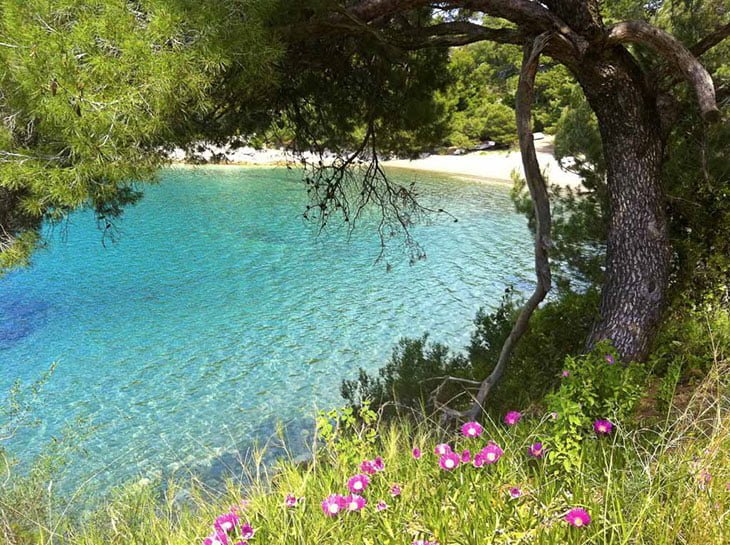
Each of the 8 parks have their own special features but Mljet National Park is quite extraordinary mainly because it is bordering on 2 saltwater lakes.
This location alone allows for activities that will be very different from what you will find in all the other parks. The park is officially a protected natural sanctuary because of this.
Mljet Island national park is in one of the largest islands in Dalmatia founded in 1960. Thousands of people visit this scenic park every year.
The area is exposed to sea and surf.
Table of Contents
Picture a sweet spot of land in between two bodies of crystal clear blue waters.
What a day trip it would be!
Far from world cultural affairs, spending even a brief amount of time in this island would leave you feeling refreshed and ready to face whatever is ahead of you.
Mljet National Park has been declared a protected territory in order to preserve its unusual features.
Where is National Park Mljet?
Mljet National Park is located in the island of Mljet near other groups of islands in southern Dalmatia.
The nearest city to the island is Dubrovnik so it would be easy to hop over to the park if Dubrovnik is your main destination.
Day trips are also available from Dubrovnik to the island and back again.
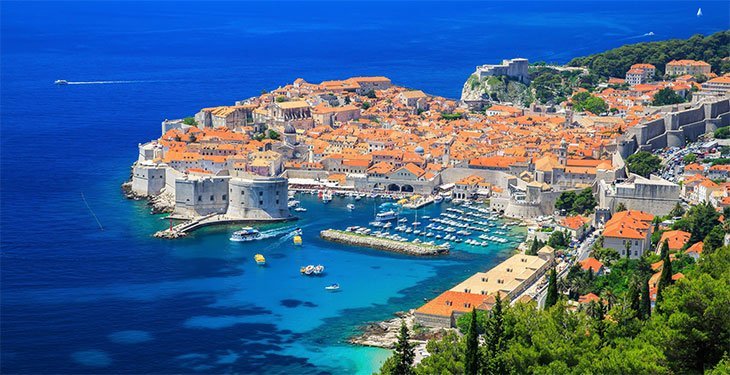
You can reach Mljet National Park by ferry from any of its nearby cities.
There are numerous charter boats available coming from Split, Island Of Hvar, and Korčula island among others.
The national park covers the western part of the island as well as the two lakes and the Soline Bay.
The small lake is called the Malo Jezero and the big lake is called the Veliko Jezero, both names are their literal translation in Croatian.
There are plenty of things to see and to do at the park, including the Benedictine monastery in the middle of a small islet.
You can hike, walk, stroll, and even bike around its many trails.
Other popular activities in Mljet National Park Croatia include kayaking and swimming.
The Big Picture: Places To Visit In Mljet National Park
This national park is the oldest marine protected area in the Mediterranean and thousands of visitors both foreign and local flock to the island to marvel at its fascinating natural beauty.
It is said that in this park, you will truly see the colors and the scent of untouched nature.
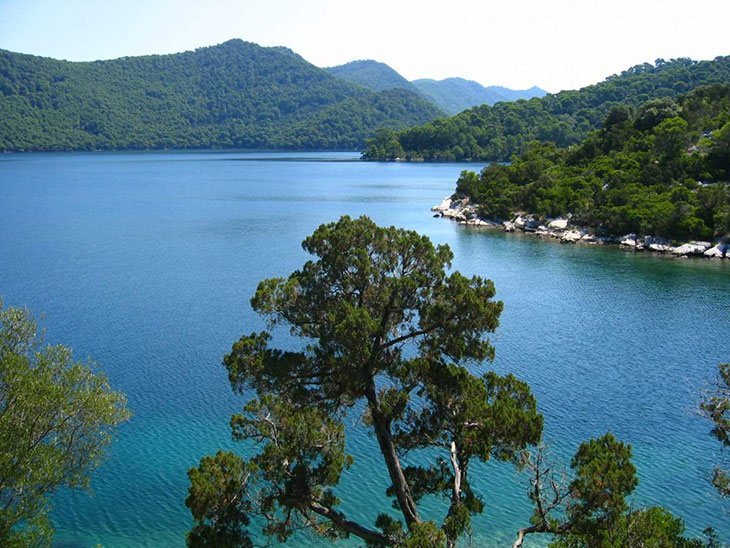
The island Mljet first gained its protected status in 1948 and on November 11, 1960, it was proclaimed a national park.
Mljet Island National Park covers an area of about 5,400 hectares including the surrounding marine as well as the islands and cliffs.
That means about one-third of the island comprises the park.
It’s a huge place so it is really advisable to take the whole day to explore the park, instead of mixing it up with other destinations in your day tour.
The two bays or lakes in between this island, which is included in the park’s area, are deep and filled with seawater.
They are popular destinations.
But more importantly, these two lakes are quite a mind-blowing geological and oceanographical phenomenon!
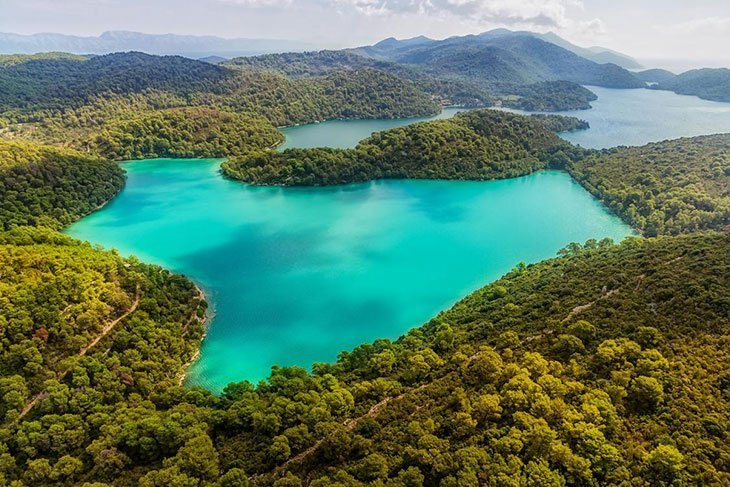
The park’s entire area is abounding with life and numerous endemic and endangered species.
This is evidence that Mljet National Park should really be under national protection.
Nature lovers will fall in love with its panoramic views and people who love learning about cultural heritage will also find lots of things to treasure in this island.
There are numerous archeological sites to marvel at which tell stories of the island’s settlers’ ancestors many years ago.
One of the most beautiful attractions inside the park is the Benedictine Monastery which is located in what could be the most scenic spot in the entire island.
You will not run out of activities to do in national park Mljet Croatia. Among these are walking or cycling.
Both are great ways to explore the island in your own pace, giving you the freedom to stop by anywhere you want at any time.
If you visit during the summer season, you should definitely take the opportunity to take a swim or scuba dive in the crystalline waters.
The island also features lots of caves that have been naturally formed along with ground erosions.
Its most popular cave is the Odyssey’s Cave which you can reach by taking a short boat ride inside the park.
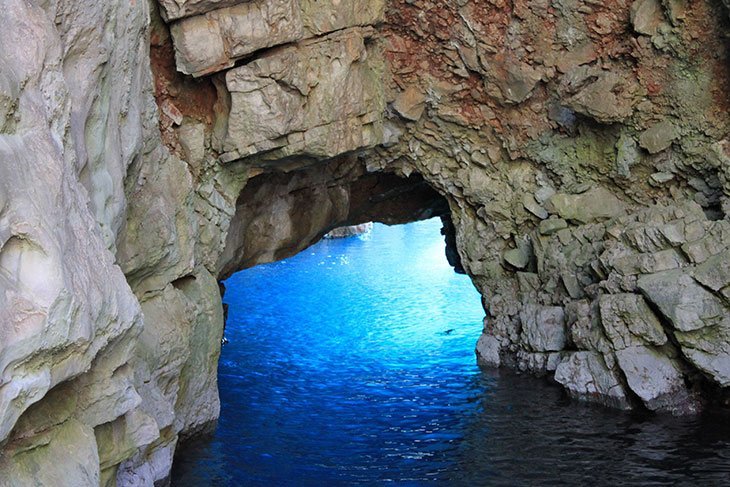
You can rent a canoe or a kayak and spend your afternoon paddling around the lakes. Just take note that the rental for such equipment are not included in the park’s entrance fees.
You could also pay a visit to the villages around the area.
There is the picturesque town of Govedari which is the first settlement in the island back in the 18th century and the Polače village which also has an interesting albeit turbulent history.
Pomona is another village to visit especially if you would like to shop for souvenir items.
Mljet Island Lakes
What is so special about the two lakes in between this island that make the park so unique and intriguing?
As mentioned, Mljet National Park is in between two saltwater lakes.
The Veliko Jezero or large lake and the Malo Jezero or small lake.
Both lakes stretch about 4 kilometers and in the middle of the two is the islet Melita where you will find the Benedictine monastery.
The lakes used to be ordinary freshwater lakes but because of the narrow channel through Soline Bay, the lakes have been connected to the sea, transforming them into saltwater lakes.
This is a unique geological and oceanographical phenomenon and one that is of significance to the whole world.
These lakes, along with the Soline Bay are the heart of Mljet National Park.
Veliko Jezero (Big Lake)
The big lake or what locals call the Veliko Jezero is actually a sea bay, originally formed because of the sunken karst coves.
You can enter this lake by sailing via Soline through a small and narrow passageway.
It is very likely that it was the Benedictines who artificially created the dredge the area to allow access to the islet during the 15th century.
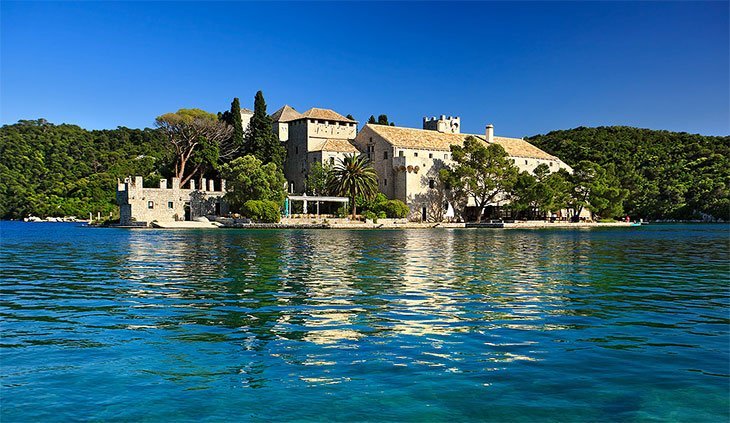
When the currents started getting stronger in the lake, with sea water washing over the channel, it affected the direction in sequences of the tides.
The Benedictine monks, smart as they are, immediately took advantage of the natural phenomenon by setting up a mill on the shore of the channel.
It is also possible that the small bridge was built around the same time.
However, the monastery eventually abandoned and by 1960, it was rebuilt into a hotel and the old mill was also destroyed.
What’s unique about this lake is that it has salty waters because it is connected to the Adriatic through the Solinski Channel.
Furthermore, there are no other outlets to the sea so the water in the Veliko Jezero does not get replaced much which makes its salinity lower than that of the sea.
That is why the lake’s water is warmer in the summer and colder in winter than the seawater’s temperature.
That is how it is different from other freshwater lakes.
The Veliko Jezero is also rich in various forms of aquatic life.
Beneath the surface, you will find grey mullets, sea bass, moray eel, scorpion fish and those are just a few examples because there are so much more!
Malo Jezero (Small Lake)
It used to be that these two lakes are connected by a channel but it was so shallow that people could not wade across.
Before World War II, while the road around the large lake is being built, they dredged a wider passage to allow small boats to pass through.
So now, you can see them as two separate lakes. At the same time, they also built a bridge called the Small Stone Bridge to allow passage on land in between the two.

The water from the small lake or Malo Jezero comes from rainwater as well as underground stream.
Its water is even hotter in the summer than the Veliko lake and a lot colder in winter than both the open sea and the big lake.
It has a much lower salinity than that of the sea but it increases going down the sea bed.
Some experts believe that there must be a direct underground connection between the small lake and the sea.
Is swimming allowed in Mljet lakes?
Because of the protected status of the Mljet National Park, it is worth mentioning that visitors are allowed to swim in the lakes.
Some parks in Croatia that are considered as protected sites such as Plitvice National Park, prohibit visitors from swimming in the waters.
At Mljet National Park, you are free to swim, sail, or kayak during permissible hours.
So, make sure to bring your swimsuits along.
However, keep in mind that people are working very hard to preserve the park’s natural beauty so please respect this and try not to cause any damage or contribute to water pollution.
Things To Do On Mljet Island
A day inside the Mljet National Park means a fun-filled day basking in the beauty of nature and plenty of underwater adventure opportunities.
There is so much to see and do so it is really best if you spend the whole day at the park to make the most of your efforts going there.
Walking and Biking
The two most popular activities in Mljet National Park are walking and biking.
You can either walk or bike on your own or join some of the walking and biking tours.
There are several walking and biking trails along the shores of the lakes and some wound in through the forests.
These tarmac and gravel roads are suitable for all types of biking.

You can bring your own bike or you can rent form the park.
Depending on where and how you purchase your tickets, some entrance fees already include the bike rental as well as some boat rides.
Walking and biking inside this extraordinary island will let you experience seeing the park in an utterly unique perspective.
It is like going inside a history book and really exploring the place as though you went back in time.
Hiking Trails On Mljet Island
Mljet National Park is also a great spot to hike. There are numerous hiking trails that stretch out all over the park.
Just be aware that park authorities have indicated borders that limit visitors to specific areas of sightseeing so do not go beyond those borders in an effort to help preserve the island’s natural beauty.
The hills go up to 200m and the peaks are a great spot to take in the stunning scenery of the Mljet island coastline.
Swimming, Kayaking, and Canoeing On Mljet Croatia
You can enjoy the waters in these saltwater lakes as much as you want in many different ways.
It is an extraordinary lake so why not take a dip?
Bring your swimsuits and your sunscreen because you will not want to get out of the water once you’re in.
It is seawater but it is so clear and mesmerizing that you almost want to drink it, but of course, don’t!
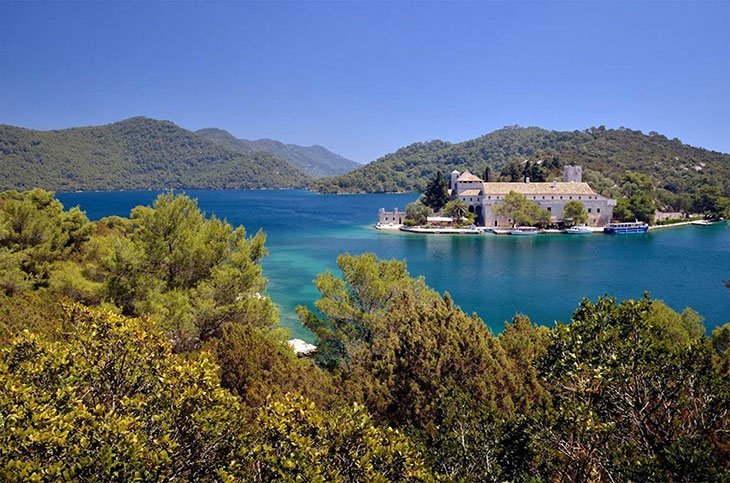
You can rent a kayak or a canoe at Mali Most which is where the big lake and the small lake meet, joined by a narrow channel.
Kayaking will also allow you to fish for fun around the lakes.
Or you can simply just paddle around while enjoying the sights. Life jackets and spray skirt are included in the kayak rental.
Island of St. Mary in Big Lake
In the big lake, you can sail toward the little isle of St. Mary in the southern part of the lake where the Benedictine monastery is located.
The Church of St. Mary is also in proximity.
There is a path from the main park going to the big lake so it is easily walkable then ride a boat to get to the islet.
The monastery has quite an interesting history. It was built between 1177 and 1198, initially by the Benedictines but was later rebuilt by the church.
The structure has undergone many changes in style and appearance throughout the centuries.
It took on a Renaissance style then Baroque but it mostly remained Romanesque in style.

The Church of St. Mary is part of the monastery which is a single nave Romanesque building.
Its interior was partitioned and extended at the same time of the installation of the coat of arms of Gundulić family on the porch.
Even after that, the monastery kept undergoing several changes.
Today, the monastery is a Romanesque structure with two levels decorated by pretty courtyards on both sides.
You should also go see the defensive tower toward the southeast side.
Climbing on top of it is a one-of-a-kind experience and you will be able to see a picturesque view of the great lake.
For a long time, it was the Benedictines who took responsibility of caring for the island, living in harmony with nature.
But they renounced their rule over some parts of the island in 1345 and that was when Mljet Croatia obtained a statute municipality.
Nevertheless, the Benedictines continued their activities through 1809 until it was closed when Napoleon came to power.
From then, the islet was handed to many different owners and the monastery was eventually neglected. It was converted into a hotel which remained in operation until 1991.
Then going forward to 1998, it was given back to the diocese of Dubrovnik and to this day, renovations are ongoing for the abandoned monastery.
Unlike other religious structures in Croatia, you will not see a lot of artifacts in the monastery but it is quite a sight because of the rich history throbbing in its walls.
There is no museum.
What you will see are old passageways that have gone through various redesigning, giving you a look of how the monks had lived within those walls back in the day.
Odysseus Cave On Mljet
Caves have naturally formed around the lakes over the years and one of the most amazing of these is the Odysseus Cave on the southern coast of the island.
The cave is famous for its egg shape and the rock formations inside are a really thrilling view.
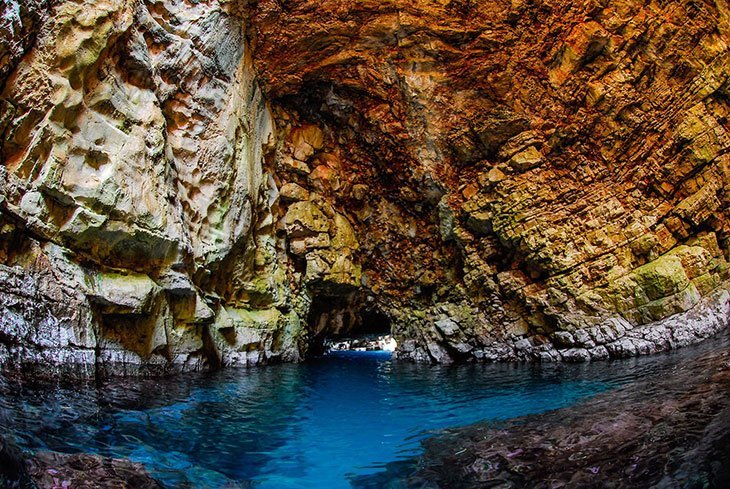
It was named after the legendary Odysseus.
They said he was shipwrecked near the cave and had to find shelter in the nearby lands.
He was swept away to the cave and was forced to stay in there for quite some time, either trying to escape the nymph Calypso who was seeking him or as a slave kept captive in the cave.
Later on, people eventually attributed this legend to the island of Malta.
According to the Greek poet, Homer, the nymph Calypso was Odysseus’ lover for seven years but he was a prisoner in the cave.
The cave is wide with a collapsed vault and to go in, you would have to swim through seawater.
You can enter it from the sea either by swimming or sailing by boat since small boats can pass through its wide opening.
You can simply look at it from its entrance or you can traverse the tunnel inside which is about 20 meters long. The sea is some 10 meters deep.
If you look at the island from the air, the cave looks like a big hole in the ground.
Layers of limestone separate the cave from the open sea waters.
If you enter and walk all the way to the end of the tunnel, you can either go back to the water or climb back up to land on a very steep and improvised stairs.
During the summer, it is best to go to the cave around noon because the light from the sun gives out a colorful glimmer in the sea.
It is an extraordinary natural phenomenon that is worthy of a professional photograph.
Sailing On Mljet Island
Another way to reach Mljet island and take a day tour there is by arriving on a sailboat or a yacht.
You can drop anchor in one of three nearby villages either in Polače, Pomena, or Lokva bay.
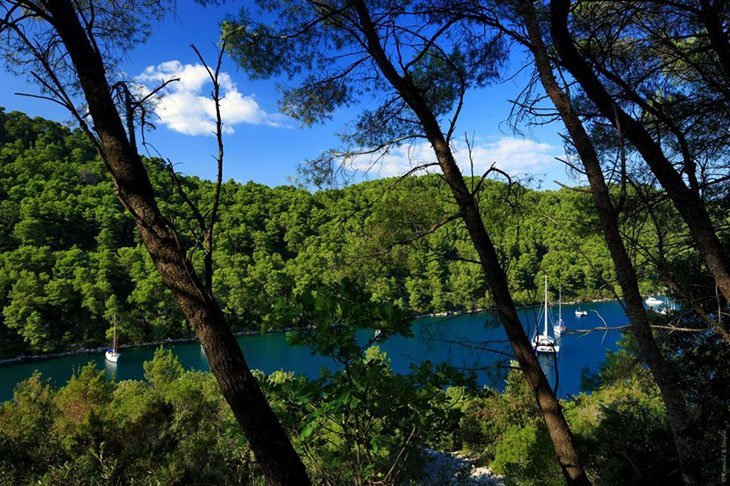
Villages On Mljet Island
Sometimes, visitors would begin their exploration of the Mljet National Park from one of the villages.
From there, they would sail through the lakes and then stop at Mljet island.
Polače
The Polače village is a settlement and harbor in the protected bay which features a number of cultural and historical structures.
Sailing to the village is a great segue in between your water activities and treks in the park.
It has a Roman palace and an ancient basilica that tell lots of stories about the village’s history.
The village has a small port in the gulf, somehow hidden behind the islands.
It’s also a great place to dine and shop since you would not find many shopping places in the park.
You can get souvenirs and even rent a place to stay for the night if you want to extend your visit to Mljet National Park.
The Mljet national park has an office in Polače where you can buy tickets and take cash from the ATM.
Pomena
You can continue your sea explorations and sports activities in Pomena village.
Here, you will find various sports fields along with diving and sailing schools.
It’s a small town and its main street is a shopping area where you will also find lots of good restaurants. You can also rent bikes and canoes.
Govedari
Aside from those two towns, you can also visit Govedari which rises on a slope of fertile fields in the island.
This village is the first settlement in Mljet that was permitted by the Benedictines to build houses and structures in the area.
Its history begins in the 18th century and its first settlers were known as shepherds and farmers which gave them the town’s name “goveda” meaning cattle in Croatian.
The village is a protected land so no one is allowed to build new houses anymore and the existing ones are not allowed to be sold.
Mljet Cultural Summer
During the summer which is the peak season, the locals celebrate a religious holiday of the Great Madonna, known to them as Velika Gospa.
Festivities start from mid July all through the 15th of August. It will be a great time to go to the islet of St. Mary to catch various concerts.
There will also be exhibitions inside the monastery during this time and all proceeds go to the reconstruction of the monastery.
Half Ironman Triathlon – Mljet Island
A traditional annual race happens in the island of Mljet during the month of October.
It is a triathlon that involves swimming, cycling, and running. It starts and ends in the most beautiful parts of the Mljet National Park.
Exploring Mljet Island
If you don’t feel like walking or riding a bike, you can take the bus that passes through all the villages in the island.
You can visit the above featured towns, Pomena, Polače, and Govedari in this way along with other towns if you are interested in them.
The park’s admin provides the mini bus as well as the boat for guests to reach the island of St. Mary.
Getting to Mljet Croatia
Mljet National Park is occupies a big part of the Mljet island. It is near Dubrovnik and you can easily get to it via a ferry boat.
The island is a part of a group of other isles in the southern part of Dalmatia toward the northwest.
Aside from Dubrovnik, you can reach Mljet National Park by taking a ferry from numerous tourist charter boats in cities like Split, Korcula, and Island Of Hvar.
These ferry rides dock their vehicles either at Pomena or Polače port.
Some people take boat rides to Sobra which is Mljet island’s main port but you would need to drive to get to Mljet National Park.
There are three official entrances to the park.
You can choose to enter from Crna Klada, Pomena, or Polače.
The fees will be the same and you can access all of the attractions in the island from any of the entrances.
If you enter from Pomena or Polače, you can walk to the main park through a system of forest paths.
Those who are part of a group tour take a particular route to tour the island.
If you and your group are not part of an organized tour, you can explore the island however you wish as you long as you comply with the park’s regulations.
Here are more details on getting to the island.
By Boat or Ferry from Dubrovnik
Mljet National Park is located in Mljet island and one of the best ways to reach it is by riding a boat or a ferry from the nearby cities.
If your main destination in your Croatia trip is Dubrovnik, then you are very lucky because there is a direct ferry ride to the park from the city as detailed above.
Other cities also offer boat rides going to Mljet National Park.
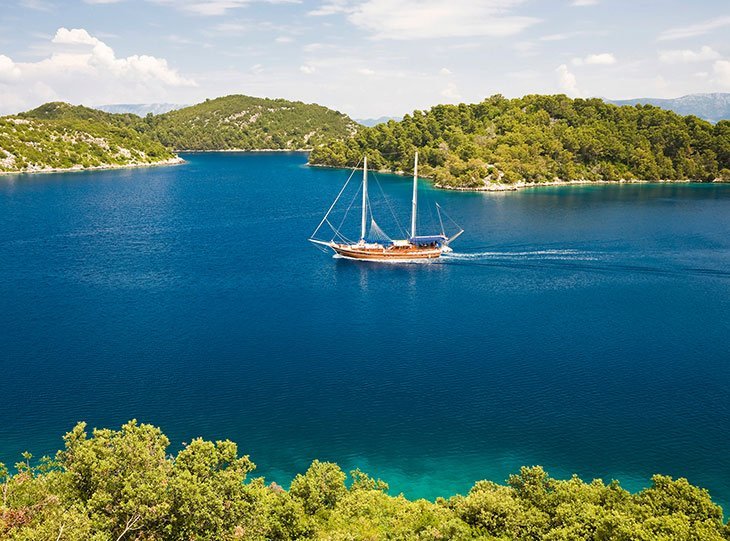
There are three boat lines going to Mljet islands.
One is the Catamaran line which comes from Dubrovnik.
There is a ferry from Prapratno located at the Pelješac peninsula going to Sobra.
Trips are only available 4 times a day so make sure to check their schedule.
From Sobra, you would have to take a car or ride a taxi going to Mljet National Park.
By Boat Or Ferry From Split
There is another Catamaran boat line coming from Split.
When taking these boat rides, be careful to read all the details in your ticket because it will indicate the meeting places or the port where your boat or ferry will be.
Arrive early because if you miss your boat ride, it will be difficult to get to the next one especially since they run on a strict schedule.
Going to Mljet by car
Going to Mljet National Park is also an option though you will eventually have to leave it somewhere to get to the park’s entrance.
None of the sea vessels going to Mljet National Park can carry cars so you either drive to a nearby location or ride a boat.
Either way, you would end up leaving your car in one of the parking spaces or public garages for a fee then ultimately taking a ferry going to the island.
A day parking ticket in Dubrovnik’s Gruž ferry port costs from 01.05.-30.09 is 30 euros and in other periods is 15 euros. Weekly parking ticket at Gruž is 60 euros off season and in season is 150 euros.
Entrance Fees To Mljet National Park
Entrance tickets to Mljet National Park vary depending on the season. There are no discounts for groups but students get a discounted rate.
From January 1st to June 14th
Tickets to Mljet National Park for individuals and groups cost 13.5 euro per person.
Children from age 7 and above as well as students and Croatian citizen pensioners pay a discounted rate of 5 euro.
Children from age 6 and below are always free to enter.
From June 15th to September 15th (Peak Season)
Tickets to Mljet National Park for individuals and groups cost 22.50 euro per person.
Children from age 7 and above as well as students and Croatian citizen pensioners still pay a discounted rate of 8 euro.
Children from age 6 and below are always free to enter.
From September 16th to December 31st
Prices go down again after the peak season:
Tickets to Mljet National Park for individuals and groups cost 13.50 euro per adult.
Children from age 7 and above as well as students and Croatian citizen pensioners pay a discounted rate of 5 euro.
Children from age 6 and below are always free to enter.
All guided tours cost 53 euros and lasts up to 2 hours.
Remember that entrance fees to the park are not inclusive of rental fees for boats and kayaks as well as other boating gears that you may need.
Tickets to the ferry ride from other cities going to the island may or may not include the entrance fee to the Mljet National Park so always confirm what is included in your package and tour.
Best Time To Visit Mljet Island
The Mljet island, the two saltwater lakes, and the park itself are all spectacular throughout the year.
Summer is the most popular time to visit because you can maximize all the activities in the water like swimming, kayaking or canoeing. You can also scuba dive in the lakes.

Festivities also happen during the summer so it’s one of the things that are great to observe.
However, take note that the sun can get very hot and that the water is hotter than the open seas so just be cautious and take necessary precautions such as putting sunscreen.
The island will be more crowded in the peak season but it will not be as packed as the other more popular destinations in Croatia like Dubrovnik or Plitvice Lakes so it is still quite manageable.
The best time to visit would depend on what you want to see and the activities that you want to do.
If you don’t want to miss out on observing the lakes’ underwater life, it is best that you plan your visit in the summer.
But even in the winter, walking along the shores are just as relaxing and you will still be able to see this island’s spectacular beauty.
If you want to witness the mini Ironman triathlon or maybe even join it, you should plan your trip in October.
Travelling to Mljet National Park With Children
Mljet National Park is a suitable destination for families traveling with children.
There is not much traffic along the paths and passageways to the great lake and the shores as well as other flat areas by the sea are safe to explore with your little ones.
Check Other Croatia National Parks
- Travel Guide For Krka National Park
- National Park Plitvice Lakes Croatia
- Things To Do In Paklenica National Park
- Best Things To Do In Risnjak Croatia
- Travel Guide For Kornati Islands National Park
- Brijuni National Park Travel Guide
- Northern Velebit National Park
